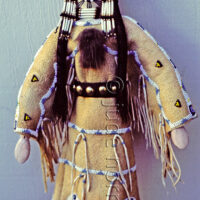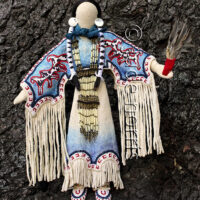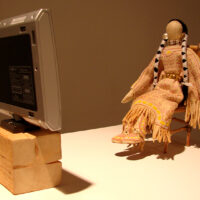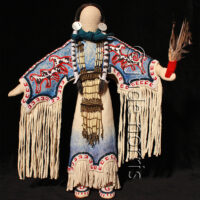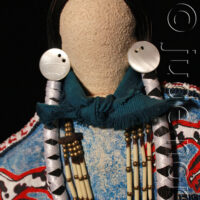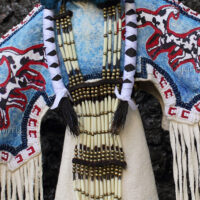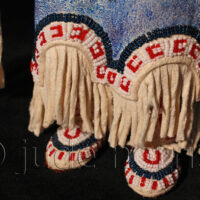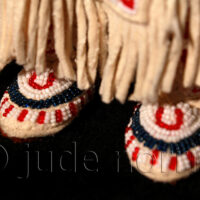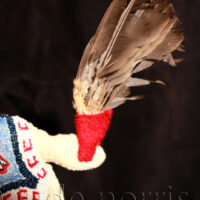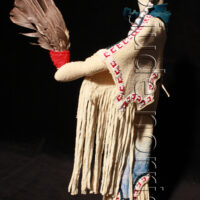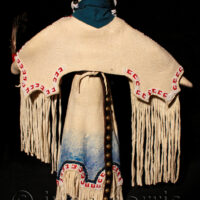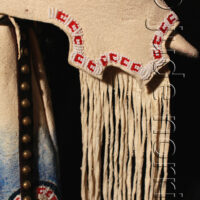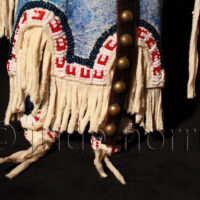click on any image to enlarge
Painted Horse Doll details:
In 2003 I travelled to Salt Lake City to do a funded Aboriginal Artists collaborative exchange with Northern Arapaho/Seneca artist and traditional dancer, Dallin Maybee. Dallin has danced with the internationally renowned Native American Dance Theater and he is well known for his beadwork and powwow regalia. He won Best in Show, Best of Division and Best of Classification artist at the prestigious Santa Fe Indian Art Market in 2007 for his children’s books featuring fully bead-worked, ledger style artwork covers, and later became the market’s director.
Dallin is also an adept doll-maker, and this was the focus of our cultural exchange. I was blessed to have the opportunity to learn this timeless and now rare craft from such a talented and knowledgeable artist. During our exchange, I also gleaned additional doll-making tips and knowledge from Dallin’s brother, Ken (Critter) Williams, himself a talented and well respected artist.
Native doll-making is much more than toy-making. It was used by Native American people for countless generations as a means to pass on important social & cultural information to children. Playing with and making dolls was a typical way for First Nations youngsters, usually girls, to learn fundamental skills needed to make clothing and other items imperative to the survival and abundance of her family and community. And like those of all cultures, Cree children used doll-play to learn, understand and develop social skills and cultural paradigms.
I did a lot of research for my first doll, and continue this practice. She is pictured above as ‘Cree Doll’. She wears turn of the century Plains Cree clothing and accessories, including a deer-tail dress and the facial tattoos commonly worn by women in our culture at that time.
I like to make my dolls historically accurate, whether their outfits are from a past or contemporary era. Their clothing and accessories are true to materials traditionally used for adult clothing or regalia. Bodies, clothing and moccasins are made from ‘brain-tanned’ deer hide which is tanned and smoked in the traditional way, using no chemicals. The hair is horse hair, and the beadwork on the dolls’ clothing is done in the tiniest ‘size 10’ hand-cut glass beads available. The small horses on ‘Horse Doll’, who wears a more contemporary powwow-style dress, are hand-painted (the horses were too tiny to bead!). Some other materials used to create the dolls include porcupine quills, abalone shell, small birds wings or feathers, satin ribbon, and animal fur. I make some of my dolls faceless, which is also a traditional practice.
I also incorporated this facelessness in a contemporary, multi-layered way, when, shortly after beginning to make dolls, I began working them into my multi-media practice, centering another plains-style traditional Native doll in my video installation piece called imperfect doll , created between 2003 and 2005 (now in the collection of the UBC Museum of Anthropology). This doll sits in a little deer-hide chair and watches herself being created on a small tv. She also has a statement hand-written all over her dress in both English and Cree. You can read more about imperfect doll (like why she is faceless and what the writing on her dress says) on the Affirm/Nation series page of the multimedia installation section of this site.
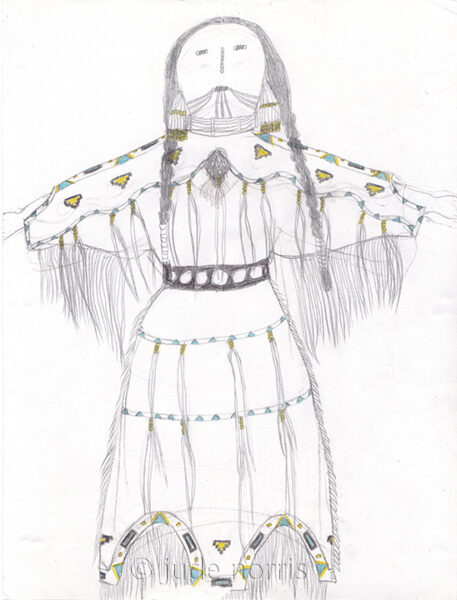
Plains Cree doll drawing (pencil & colored pencil on paper) 2003
